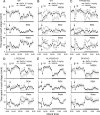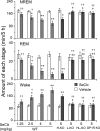Lipocalin-type prostaglandin D synthase produces prostaglandin D2 involved in regulation of physiological sleep
- PMID: 17093043
- PMCID: PMC1693853
- DOI: 10.1073/pnas.0608581103
Lipocalin-type prostaglandin D synthase produces prostaglandin D2 involved in regulation of physiological sleep
Abstract
Prostaglandin (PG) D2 has been proposed to be essential for the initiation and maintenance of the physiological sleep of rats because intracerebroventricular administration of selenium tetrachloride (SeCl4), a selective inhibitor of PGD synthase (PGDS), was shown to reduce promptly and effectively the amounts of sleep during the period of infusion. However, gene knockout (KO) mice of PGDS and prostaglandin D receptor (DP1R) showed essentially the same circadian profiles and daily amounts of sleep as wild-type (WT) mice, raising questions about the involvement of PGD2 in regulating physiological sleep. Here we examined the effect of SeCl4 on the sleep of WT and KO mice for PGDS and DP1R and that of a DP1R antagonist, ONO-4127Na, on the sleep of rats. The i.p. injection of SeCl4 into WT mice decreased the PGD2 content in the brain without affecting the amounts of PGE2 and PGF(2alpha). It inhibited sleep dose-dependently and immediately after the administration during the light period when mice normally sleep, increasing the wake time; and the treatment with this compound resulted in a distinct sleep rebound during the following dark period. The SeCl4-induced insomnia was observed in hematopoietic PGDS KO mice but not at all in lipocalin-type PGDS KO, hematopoietic and lipocalin-type PGDS double KO or DP1R KO mice. Furthermore, the DP1R antagonist ONO-4127Na reduced sleep of rats by 30% during infusion into the subarachnoid space under the rostral basal forebrain at 200 pmol/min. These results clearly show that the lipocalin-type PGDS/PGD2/DP1R system plays pivotal roles in the regulation of physiological sleep.
Conflict of interest statement
The authors declare no conflict of interest.
Figures




Similar articles
-
[Molecular mechanisms of insomnia].Nihon Rinsho. 2009 Aug;67(8):1489-93. Nihon Rinsho. 2009. PMID: 19768929 Japanese.
-
Role of the L-PGDS-PGD2-DP1 receptor axis in sleep regulation and neurologic outcomes.Sleep. 2019 Jun 11;42(6):zsz073. doi: 10.1093/sleep/zsz073. Sleep. 2019. PMID: 30893431 Free PMC article. Review.
-
Prostaglandin D(2) is crucial for seizure suppression and postictal sleep.Exp Neurol. 2014 Mar;253:82-90. doi: 10.1016/j.expneurol.2013.12.002. Epub 2013 Dec 10. Exp Neurol. 2014. PMID: 24333565
-
Prostaglandin D2 regulates joint inflammation and destruction in murine collagen-induced arthritis.Arthritis Rheum. 2012 Jan;64(1):130-40. doi: 10.1002/art.30656. Arthritis Rheum. 2012. PMID: 21898357
-
Molecular mechanisms of sleep-wake regulation: a role of prostaglandin D2.Philos Trans R Soc Lond B Biol Sci. 2000 Feb 29;355(1394):275-80. doi: 10.1098/rstb.2000.0564. Philos Trans R Soc Lond B Biol Sci. 2000. PMID: 10724461 Free PMC article. Review.
Cited by
-
Mammalian sleep genetics.Neurogenetics. 2012 Nov;13(4):287-326. doi: 10.1007/s10048-012-0341-x. Epub 2012 Sep 14. Neurogenetics. 2012. PMID: 22976546 Review.
-
Estradiol modulates recovery of REM sleep in a time-of-day-dependent manner.Am J Physiol Regul Integr Comp Physiol. 2013 Aug 1;305(3):R271-80. doi: 10.1152/ajpregu.00474.2012. Epub 2013 May 15. Am J Physiol Regul Integr Comp Physiol. 2013. PMID: 23678032 Free PMC article.
-
The Mutual Interaction Between Sleep and Epilepsy on the Neurobiological Basis and Therapy.Curr Neuropharmacol. 2018;16(1):5-16. doi: 10.2174/1570159X15666170509101237. Curr Neuropharmacol. 2018. PMID: 28486925 Free PMC article. Review.
-
The Leptomeninges Produce Prostaglandin D2 Involved in Sleep Regulation in Mice.Front Cell Neurosci. 2018 Oct 11;12:357. doi: 10.3389/fncel.2018.00357. eCollection 2018. Front Cell Neurosci. 2018. PMID: 30364224 Free PMC article.
-
Essential role of dopamine D2 receptor in the maintenance of wakefulness, but not in homeostatic regulation of sleep, in mice.J Neurosci. 2010 Mar 24;30(12):4382-9. doi: 10.1523/JNEUROSCI.4936-09.2010. J Neurosci. 2010. PMID: 20335474 Free PMC article.
References
Publication types
MeSH terms
Substances
LinkOut - more resources
Full Text Sources
Other Literature Sources
Molecular Biology Databases
Research Materials
Miscellaneous

